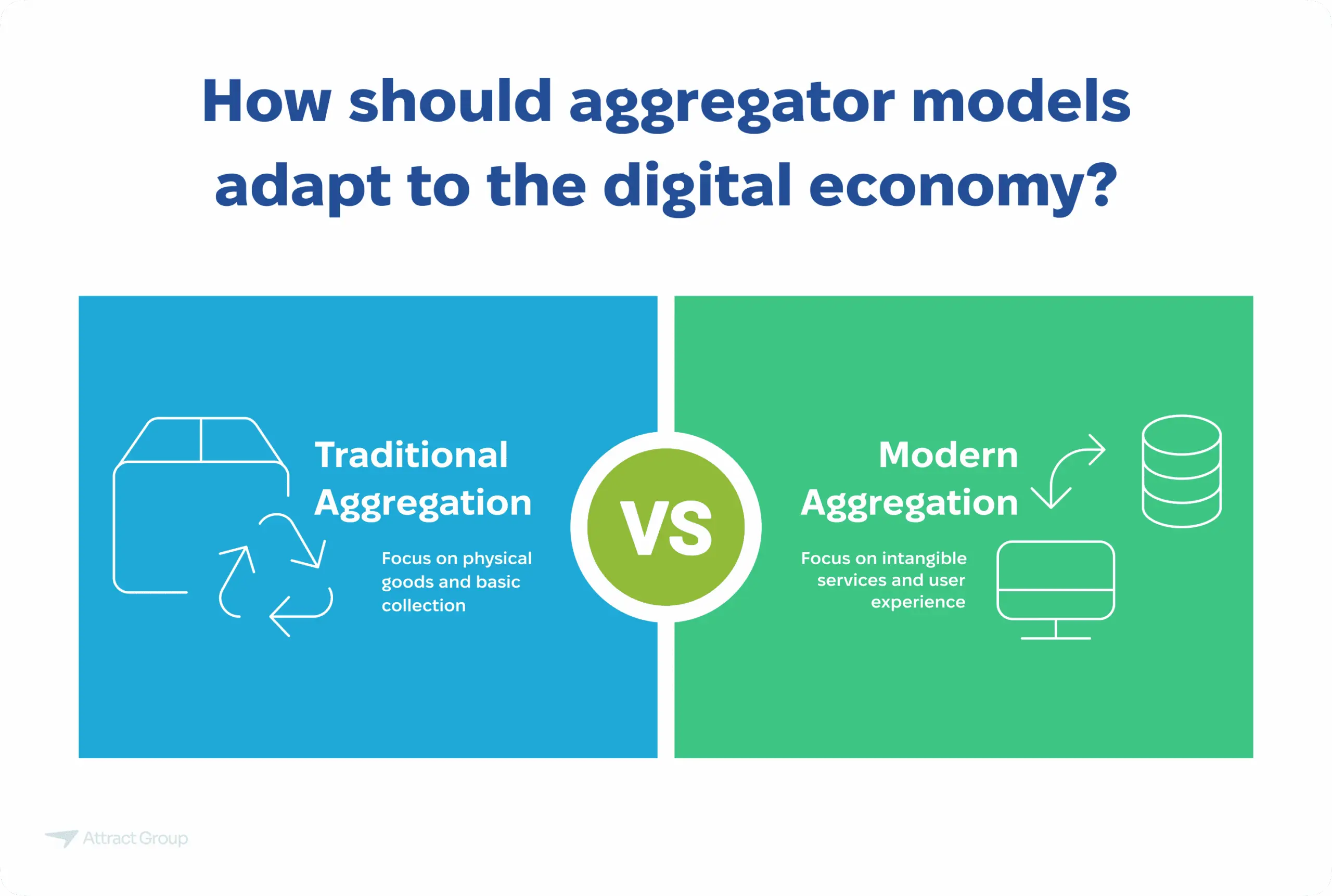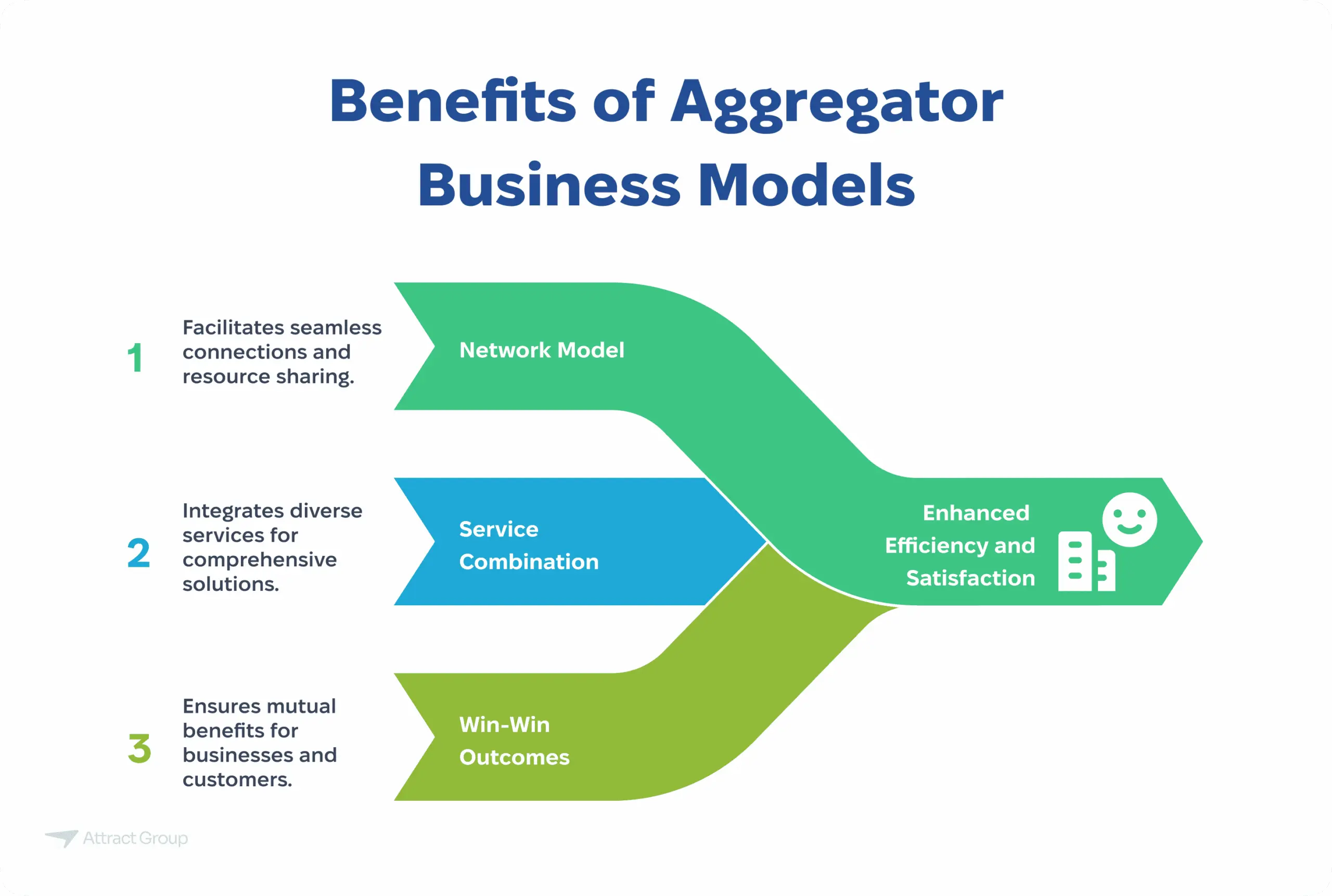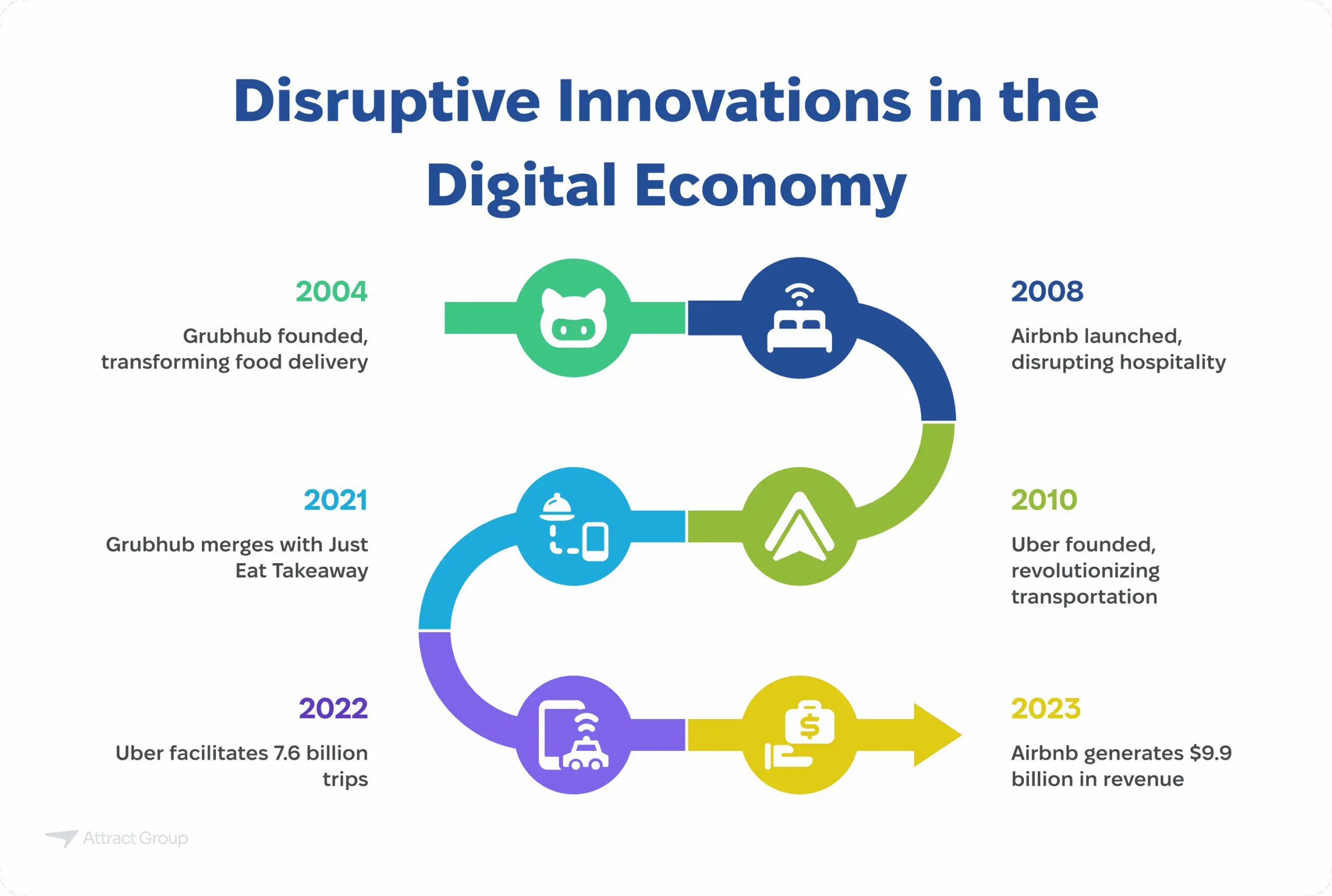Complete Guide to Aggregator Business Model & Marketplaces
 8 September 2024
8 September 2024🔊 Listen to the Summary of this article in Audio
The aggregator business model represents a significant evolution in the way products and services are offered. Unlike traditional marketplaces, aggregators provide a one-stop platform that seamlessly integrates various offerings. This approach transforms the experience for both businesses and customers. In this comprehensive guide, we’ll delve into the intricacies of both aggregator and marketplace models, examining their unique strengths and weaknesses. We’ll also explore the ongoing debate between these two models. Companies like Uber exemplify the success of aggregators, demonstrating their potential for rapid growth and market dominance. As we explore the details of aggregator models, it’s evident that they are more than just a passing trend; they signify a fundamental shift in how businesses compete and scale in the digital era.
Key Takeaways
- Understanding the fundamental differences between the aggregator business model and marketplace business model.
- Realizing the benefits and drawbacks that accompany the aggregator and marketplace business dynamics.
- Anticipating the practical strategies to navigate the aggregator vs marketplace debate.
- A discernment of the pivotal role technology plays in empowering aggregators.
What is an Aggregator Business Model?
It combines different products or services from various suppliers into one brand. It is mainly used by aggregator firms. This approach aims to improve customer experience by offering a centralized service. It helps in building a strong brand identity by providing diverse offerings from multiple sources.
History and Evolution of Aggregator Models
The aggregator model has changed a lot due to digital technology. Initially, it was about collecting physical goods. But the internet and mobile tech brought new approaches. Now, this model focuses on gathering intangible services, benefiting companies like Uber and Airbnb.
As the digital economy grew, the aggregator model evolved. It now puts more focus on user experience, growing the platform, and maintaining good partner relationships. This flexibility allows the aggregator model to innovate and successfully enter different markets.

Key Characteristics of Aggregator Business Models
They are known for centralized control, standardizing services, creating network effects, and having various revenue streams. These features make operations smooth and increase what service providers and users get out of it.
Centralized Control
An aggregator company is known for its centralized control. This means they manage everything, from choosing partners to setting terms and conditions. Centralizing decisions helps maintain consistent services. This is key to keeping a brand’s integrity and trust with users.
Standardization of Services
Aggregators must standardize their services to be reliable and trustworthy. They set strict rules and service levels for their partners. This ensures customers always get top-notch service, no matter the provider. It solidifies the aggregator’s name as a mark of quality.
Network Effects
For an aggregator, the bigger the network, the better. Each new user or provider adds more value to the platform. This is called network effects. It helps the aggregator app grow naturally. This growth boosts the user base and services without upping marketing costs.
Revenue Streams
Revenue models are key to an aggregator’s success. They make money mainly through commissions or transaction fees. But, many are exploring new ways to earn, like ads, premium listings, and subscriptions. These strategies ensure steady money flow. They keep the platform appealing to users and service providers alike.
Types of Aggregator Business Models
There are various types of ABM, shaped by technology and consumer needs. These models connect service providers and consumers in different sectors. They are categorized based on their function and sector focus.
Type 1: Service Aggregators
Service aggregators have changed industries where direct services ofes are essential. One key example is taxi aggregators. They make booking transport services easy.
Platforms connect customers with taxis through a simple app. They provide info on availability, pricing, and service details. This model has proven effective in offering solutions for daily needs.
Type 2: Product Aggregators
Product aggregators focus on selling goods. They are key in e-commerce, giving customers a unified view of products. This includes sorting by type, price, and brand.
They not only make shopping easier but also help sellers reach more customers. This is crucial in the competitive online market.
Type 3: Information Aggregators
Information aggregators gather data from different sources. They offer users a detailed summary of their search. This model is widely used by financial sites for market insights or by news sites for global events.
They save users time by avoiding visits to multiple sites for a full story or data.
| Aggregator Type | Focus Area | Key Features | Example Industries |
|---|---|---|---|
| Service | Real-time service booking | Mobile app, real-time updates, customer and service provider ratings | Transportation, Home Services |
| Product | Ecommerce | Wide product range, detailed product descriptions, easy comparison | Retail, Consumer Goods |
| Information | Data Synthesis | Comprehensive data, user-friendly interfaces, source variety | Finance, News Media |
How do ABMs Work?
The success of an ABM lies in merging top-notch technology with strong strategies. This blend attracts a huge customer base and ensures smooth partnerships. Let’s look at how technology, engaging customers, managing partners, and making money are key to these businesses.
Role of Technology
When comparing aggregator and marketplace businesses, technology stands out. A successful aggregator’s heart is its tech platform. It must support and enhance how users and service providers interact. This includes handling lots of data and updating availability in real-time.
Our expert developers can create a custom, scalable technology solution to power your aggregator business, ensuring seamless interactions between users and service providers.

Customer Acquisition and Retention
For a strong customer base, aggregators work on improving user experience and satisfaction. They use loyalty programs, tailored offers, and quick customer service. These efforts help in attracting and keeping customers.
Partner Management
Effective partnership strategies are vital in aggregator models. It’s all about win-win relationships with service providers. Fair profit sharing, promises of volume, and marketing help keep partners happy and services top-notch.
Monetization Strategies
- Commission on Transactions: A percentage of each transaction processed through the platform.
- Subscription Fees: For premium features offered to users or service providers.
- Advertisement: Generating revenue from ads displayed on the aggregator platform.
| Strategy | Description | Benefits |
|---|---|---|
| Commission on Transactions | A certain percentage is taken from each transaction | Steady income dependent on platform activity levels |
| Subscription Fees | Charging for advanced features | Consistent revenue, encourages loyalty |
| Advertisement | Selling ad space to third-party businesses | Additional revenue stream not dependent on user transactions |
Marketplaces vs. Aggregators: Key Differences
Understanding the difference between marketplace and aggregator models is essential. It’s especially important for entrepreneurs and investors in digital commerce. Marketplaces and aggregators both use the internet to connect people but work differently in terms of structure, how they operate, and how they make money.
Definition and Examples of Marketplaces
A marketplace connects sellers and buyers for direct transactions. This platform hosts transactions and makes money through fees or premium services. Sites like Amazon and eBay are perfect examples, allowing sellers to offer products to buyers directly.
Comparison of Business Structures
An aggregator brings together information or services under one brand. Unlike marketplaces, aggregators manage offerings, often setting prices. Uber and Airbnb are examples of this, standardizing services and focusing customer interactions with the aggregator, not with individual service providers.
Revenue Models Comparison
Marketplaces and aggregators have different ways to earn money. Marketplaces may charge transaction fees, subscriptions, or ad fees. Aggregators might take commissions from providers or charge for premium listings. Knowing the differences helps choose the right model for a business.
Choosing between a marketplace or an aggregator model depends on your business goals. It also depends on the industry you’re in and how much control you want over the services or products offered.
Advantages of Aggregator Business Models
The ABM changes industries by using a network model. It gives big benefits to businesses and customers. This model combines many services or products on one platform. It’s more efficient and often creates a win-win situation. Here we look at the main benefits of this model.

Scalability
The aggregator model is great because it can grow easily. Businesses can offer more without huge costs. Unlike traditional models, aggregators need less money for inventory and buildings as they grow.
High Profit Margins
Aggregators make more money. Each new user makes the platform better for others and boosts business. They save on making products and spend on tech and user experience. This way, they earn more with each transaction.
Strong Customer Loyalty
Aggregators can offer more choices and deals. This makes customers loyal. People love using one place that offers great value and convenience. It keeps users coming back, happy with the simple, effective service.
| Feature | Traditional BMs | Aggregator BMs |
|---|---|---|
| Capital Investment | High (due to need for physical assets) | Low (focus on platform rather than assets) |
| Customer Reach | Limited by geographical and physical constraints | Expanded by online presence and wide network |
| Profit Margin | Varies significantly across industries | Generally higher due to lower operational costs |
| User Experience | Often varies and can be inconsistent | Standardized service leading to user reliability and trust |
Challenges Faced by Aggregator Business Models
They play a key role in changing industries. They do this by bringing together services and products. This makes things easier for consumers. Yet, they face big challenges that can slow down their growth.
Market Saturation
The competition among aggregators is very strong. Many companies are trying to get the attention of customers. This is especially tough in markets that are already full. Here, new companies make it harder for existing ones. They can reduce their market share and profits.
This situation makes it hard for businesses to grow. They have to keep creating new things. Otherwise, they might become outdated.
Regulatory Issues
Dealing with rules and laws can be hard for aggregators. The rules are not the same everywhere. It’s very important for them to follow these rules, or they could face big fines and harm their reputation. They must quickly adjust to new laws to keep running smoothly.
Maintaining Quality Standards
Keeping high quality is a must as aggregator models get bigger. Customers want services they can rely on. So, aggregators need to make sure everyone in their network meets high standards. This builds trust and keeps customers happy.
Let our experienced team develop tailored software solutions to address market saturation, regulatory compliance, and quality control issues in your aggregator business.
Case Studies
The digital age has brought the ABM to the forefront, revolutionizing access to services. This section delves into the impact of industry giants showcasing how they have reshaped transportation, hospitality, and food delivery.
Uber: Revolutionizing Transportation
Uber’s rise from a luxury car service to a global transportation powerhouse is a testament to its disruptive potential. The company, which launched in 2010, now operates in over 10,000 cities across 72 countries. This connects over 131 million monthly active users with 5.4 million drivers, facilitating more than 7.6 billion trips in 2022 alone. This scale and efficiency have drastically disrupted traditional taxi industries worldwide, contributing to a valuation of approximately $90 billion as of 2023. Source
Airbnb: Disrupting the Hospitality Industry
Airbnb has transformed the hospitality sector since its inception in 2008. With a global user base of around 265 million, Airbnb now offers over 7.7 million listings managed by 4 million hosts in more than 100,000 cities. In 2023, the company generated $9.9 billion in revenue, marking a 19.2% increase from the previous year. Airbnb’s ability to adapt, including its pivot during the pandemic to offer long-term rentals, has solidified its place as a leader in the digital economy, challenging traditional hotel chains. Source
Grubhub: Transforming Food Delivery
Founded in 2004, Grubhub has grown into one of the leading food delivery platforms in the United States. Serving 22.6 million users across 4,000 cities, the platform handles millions of orders annually, driving significant revenue through commissions and delivery fees. In 2021, Grubhub merged with Just Eat Takeaway, creating a combined entity with an annual revenue of $3 billion, making it the largest food delivery operator globally. Despite fierce competition from the likes of DoorDash, Grubhub remains a key player, leveraging its vast network and user base to maintain its market position. Source

How to Start Your Own Aggregator Business
Starting an aggregator business calls for careful planning. You must find a viable niche and plan every step up to launch. It’s important to map out each step for a great start in this tough field.
Identifying a Niche Market
Finding the right niche market is critical for your business. Look into current needs, trends, and areas lacking services. Picking an appropriate niche sets a solid base for your business and helps it grow.
Building the Technology Platform
A strong technology platform is key to an aggregator business. Focus on building a platform that’s robust, scalable, and easy to use. It should feature an easy interface, process data quickly, and protect user data. Your platform’s success hinges on handling transactions smoothly.
Developing Partnerships
In the world of aggregator businesses, partnerships are essential. Working with reliable providers ensures your users have great options. Aim for deals that benefit everyone, supporting your business’s growth.
Marketing and Growth Strategies
Focus your marketing on growing your brand and drawing in users and providers. Use digital marketing, PR, and targeted ads effectively. A good launch strategy boosts your growth early on.
| Phase | Focus Area | Description |
|---|---|---|
| 1. Niche Market Identification | Market Analysis | Assess market needs, trends, and gaps. |
| 2. Technology Platform | Development | Build a scalable and secure platform. |
| 3. Partnership Development | Network Expansion | Establish agreements with key providers. |
| 4. Marketing | Growth Acceleration | Implement aggressive marketing campaigns. |
Our skilled developers can create a secure, user-friendly, and scalable platform tailored to your specific aggregator business needs, setting you up for success from day one.
Conclusion
We’ve gone through the details of the aggregator model. We looked at what makes marketplaces and aggregators different. We also saw what makes aggregator businesses succeed. Understanding these businesses shows us their importance in today’s economy. They focus on bringing everything together, setting standards, and building strong networks. This approach helps them stand out in many industries.
When comparing marketplaces and aggregators, we noticed some key differences. These include how they control their operations and create value. Studies showed us how these change industries. They also show different ways to be successful. This is useful for anyone wanting to start an aggregator business. It shows the need for innovation and smart market strategies.
The future of aggregator models looks bright, with more changes on the way. Advances in technology and shifts in what consumers want will keep evolving the business. This fast change offers chances for those who can keep up. In today’s connected world, aggregators show the strength of working together and smart planning. Both new and experienced business people can learn a lot from these models. They guide us through the complex world of business today.
FAQs
How Does the ABM Differ from the Marketplace Business Model?
An aggregator makes sure the service is the same for all customers. This means a consistent experience no matter the supplier. On the other hand, a marketplace offers a variety of products or services. It maintains the uniqueness of sellers without making everything the same.
What Role Does Technology Play in the Aggregator Business Model?
Technology is key. It builds a platform that brings together different offerings. This technology manages sales and keeps customers engaged through apps and websites. It also helps the aggregator work well with its service providers.
What Are Some Common Revenue Streams for Aggregator Businesses?
These businesses make money in a few ways. They may charge service providers a fee for each sale, offer premium services for a subscription fee, and charge for ads to promote certain offerings more visibly on the platform.
What Challenges Do ABM Face?
These businesses often struggle with a lot of competition, which makes it hard to stand out. They also face strict rules that can change based on where they operate. Plus, it’s tough to keep their quality high as they grow.
Why Do ABM Prioritize Standardization of Services?
Standardized services mean customers know what to expect. This builds trust and loyalty towards the brand. This consistency ensures that the service feels the same, no matter who supplies it.
How Do Aggregators Ensure a Win-Win Strategy for Both Customers and Providers?
It offers a great deal of convenience and quality to customers. For providers, they bring in more customers and take care of marketing. This setup benefits everyone involved.
How Has the ABM Evolved Over Time?
Starting with simple digital lists, the model has grown. Now, it offers complete solutions for delivery, payment, and customer service. It’s in nearly every industry and keeps changing with new tech.










